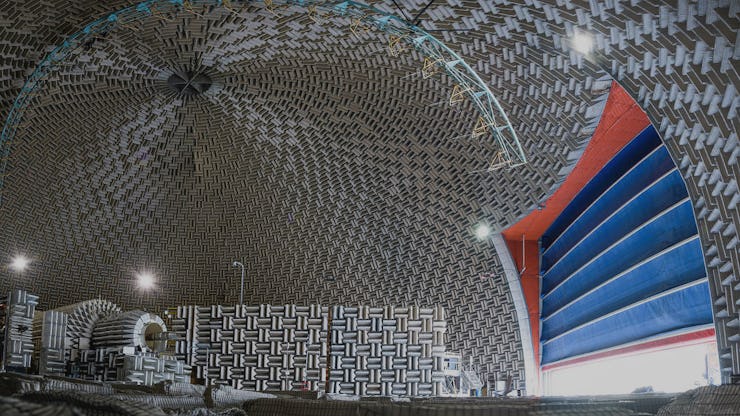NASA Built a Giant Silver Dome So Future Planes Won't Make You Deaf
This is NASA's answer to noise pollution.

If you’ve ever lived near an airport or under a prominent airway, you’ve probably been rudely awakened by the whooshing of 100 tons of aluminum flying over your head. Unfortunately, with demand for faster aircraft, travel noise pollution could get a lot worse for those residing near a runway. But not if NASA has something to say about it.
Acoustics experts at the space agency’s Glenn Research Center in Cleveland are using the facility’s Aero-Acoustic Propulsion Laboratory (AAPL) — AKA the big ol’ dome — to evaluate the ruckus produced by jet engines. This rotund establishment has been used for auditory experiments for over 20 years and was recently used to evaluate the noise levels of a Learjet engine. This is where the turbines of the future will be tested in the hopes that engineers figure out a way to not deafen us all.
Join our private Dope Space Pics group on Facebook for more strange wonder.
“This recent test succeeded in creating a simulated environment which closely matched flight tests, and the results provide us with a unique opportunity to investigate how well noise levels produced in the lab can be compared with flight test noise data,” said NASA research engineer Dennis Huff in a statement released Tuesday.
The dome is 65 feet high and 130 feet in diameter — making it a little over three giraffes tall and 12 alligators wide. All of those weird-looking bricks that cover the dome’s interior are 17,000 custom-designed fiberglass wedges to soak up those sound waves. This ensures there’s no echoing, which would make the jet engine seem a lot louder than it actually is.
To the bottom left of the image, you’ll see what what looks like the hilt of a giant lightsaber. That’s the Nozzle Acoustic Test Rig, a fancy wind tunnel designed specifically for acoustic and aerodynamic testing. Air is blasted through it so experts can simulate take-off and landing conditions up to speeds of 268.5 mph.
Nozzle Acoustic Test Rig (NATR) in the Aero-Acoustic Propulsion Laboratory (AAPL).
The light blue curve at the top of the photo is an array of microphones that measure noise levels and simulate a flyover. And the big blue door to the right is opened after testing to release the air from the test.
NASA has already tested retrofitting engines with acoustic liners to reduce noise emissions in jets. Testing of this volume dampening tech and other airplane innovations will all take place in the AAPL.
It all goes down in the dome.